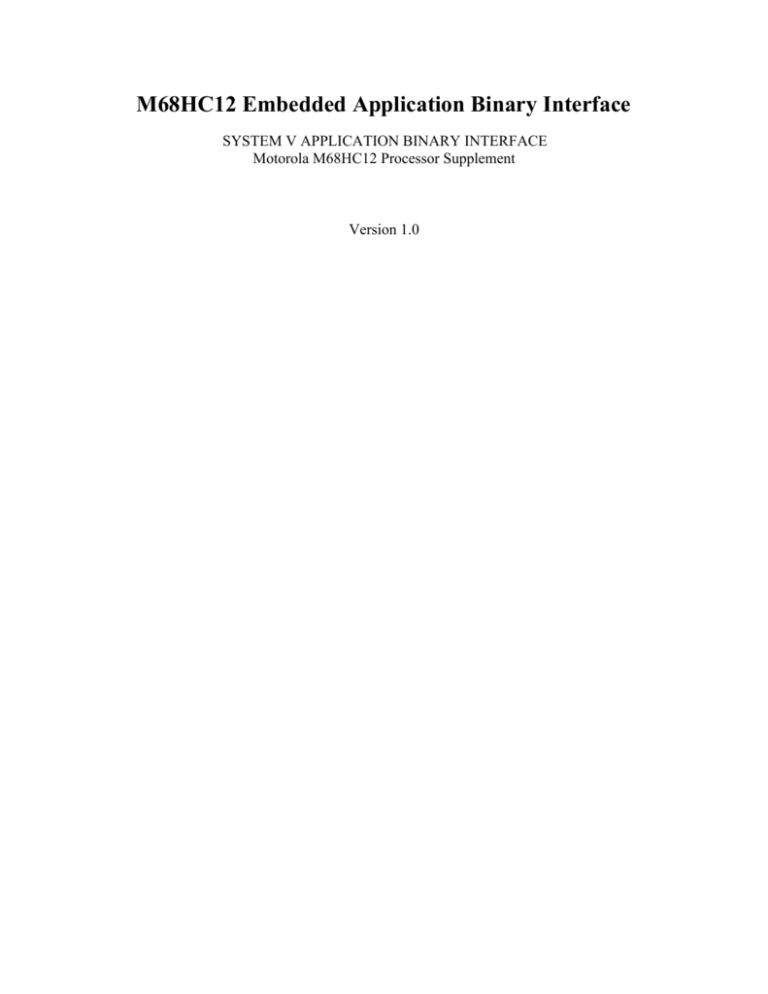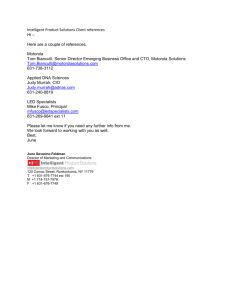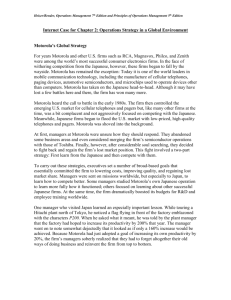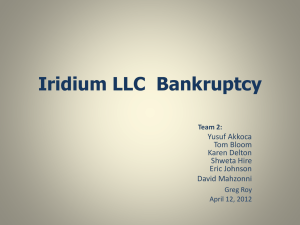
M68HC12 Embedded Application Binary Interface
SYSTEM V APPLICATION BINARY INTERFACE
Motorola M68HC12 Processor Supplement
Version 1.0
Copyright 1998 Motorola, Inc. All rights reserved.
Copyright 1990-1992 The Santa Cruz Operation, Inc. All rights reserved.
Copyright 1991,1992 88open Consortium Ltd.. All rights reserved.
This specification includes material copyrighted by 88open Consortium Ltd., which is reproduced with
permission.
This specification includes material copyrighted by The Santa Cruz Operation, Inc. which is reproduced
with permission.
Important Notice to Users
While every effort has been made to ensure the accuracy of all information in this document,
Motorola assumes no liability to any party for any loss or damage caused by errors or omissions
or by statements of any kind in this document, its updates, supplements, or special editions,
whether such errors are omissions or statements resulting from negligence, accident, or any other
cause. Motorola further assumes no liability arising out of the application or use of any
information, product, or system described herein; nor any liability for incidental or consequential
damages arising from the use of this document. Motorola disclaims all warranties regarding the
information contained herein, whether expressed, implied or statutory, including implied
warranties of merchantability or fitness for a particular purpose . Motorola makes no
representation that the interconnection of products in the manner described herein will not
infringe on existing or future patent rights, nor do the descriptions contained herein imply the
granting or license to make, use, or sell equipment constructed in accordance with this
description.
Trademarks
Motorola is a trademark of Motorola, Inc.
The Santa Cruz Operation is a registered trademark of The Santa Cruz Operation, Inc. in the
USA and other countries.
88open is a registered trademark of 88open Consortium Ltd.
ii
M68HC12 EABI Version 1.0
References
System V Application Binary Interface, Fourth Edition, UNIX System Laboratories,
1995.
System V Application Binary Interface, Motorola 88000 Processor Supplement, 88open
Consortium Ltd., 1992.
DWARF Debugging Information Format, Revision 2.0.0, Industry Review Draft, UNIX
International, Programming Languages SIG, July 27, 1993.
CPU12 Reference Manual, Motorola, 1996.
iii
M68HC12 EABI Version 1.0
Motorola
Consumer Systems Group, Core Technologies Center
1. INTRODUCTION..................................................................................................................................... 2
THE MOTOROLA M68HC12 P ROCESSOR AND THE SYSTEM V ABI ............................................................. 2
HOW TO USE THE M68HC12 EABI ............................................................................................................. 3
EVOLUTION OF THE EABI SPECIFICATION ................................................................................................... 3
2. SOFTWARE INSTALLATION .............................................................................................................. 4
3. LOW-LEVEL SYSTEM INFORMATION ............................................................................................ 5
SYSTEM V ABI EXECUTION SUPPORT ......................................................................................................... 5
MACHINE INTERFACE .................................................................................................................................. 5
Processor Architecture........................................................................................................................... 5
Data Representation............................................................................................................................... 5
FUNCTION CALLING SEQUENCE ................................................................................................................... 7
OPERATING SYSTEM INTERFACE.................................................................................................................. 7
4. OBJECT FILES ....................................................................................................................................... 8
INTRODUCTION ............................................................................................................................................ 8
DATA REPRESENTATION .............................................................................................................................. 8
ELF HEADER ............................................................................................................................................... 9
Machine Information............................................................................................................................. 9
SECTIONS ................................................................................................................................................... 10
Special Sections.................................................................................................................................... 10
Relocation............................................................................................................................................. 11
5. PROGRAM LOADING AND DYNAMIC LINKING ........................................................................ 12
6. LIBRARIES............................................................................................................................................ 13
7. DWARF DEBUGGING INFORMATION FORMAT........................................................................ 14
DWARF DEFINITION................................................................................................................................. 14
DWARF Register Number Mapping ................................................................................................... 14
Target-Specific Addressing Information ............................................................................................. 15
Calling Convention Encodings ............................................................................................................ 17
8. S-RECORDS .......................................................................................................................................... 19
S-RECORD ADDRESS FORMAT ................................................................................................................... 19
1
M68HC12 EABI Version 1.0
Motorola
Consumer Systems Group, Core Technologies Center
1. INTRODUCTION
The Motorola M68HC12 Processor and the System V ABI
The System V Application Binary Interface, or System V ABI, defines a system interface for
compiled application programs. Its purpose is to establish a standard binary interface for
application programs on systems that implement the operating system interfaces defined in the
System V Interface Definition, Fourth Edition.
The M68HC12 Embedded Application Binary Interface (which will be referred to as the EABI),
described in this document, supplements the generic System V ABI, and it contains information
specific to an implementation on the Motorola M68HC12 processor architecture. Together,
these two specifications, the generic System V ABI and the EABI, constitute a complete System V
Application Binary Interface for systems that implement the architecture of the M68HC12
processor.
The issues addressed in the EABI are considerably narrower in scope than the generic System V
ABI. The EABI was created to meet the unique needs of M68HC12 embedded applications and
tools, and does not discuss the many high-level operating system interfaces addressed in the
generic System V ABI. The focus is primarily on the low-level system information and object
files (ELF file format).
The EABI specifies DWARF 2.0 as the debugging information format. This format is described
in DWARF Debugging Information Format, Revision 2.0.0.
Version 1.0 of the EABI defines a set of conventions for linked executable files. The goal is to
define a standard that will permit a file produced by one vendor’s linker to be consumed by
another vendor’s debugger, programmer, etc.
2
M68HC12 EABI Version 1.0
Motorola
Consumer Systems Group, Core Technologies Center
How to Use the M68HC12 EABI
While the generic System V ABI is the prime reference document, the EABI contains M68HC12
processor-specific implementation details, some of which supersede information in the generic
one.
As with the System V ABI, this document refers to other publicly available reference documents
(e.g. CPU12 Reference Manual, DWARF Debugging Information Format Revision 2.0.0). All
the information referenced by the EABI should be considered part of the EABI, and just as
binding as the requirements and data it explicitly includes.
Evolution of the EABI Specification
Characteristics and behaviors mandated by this version of the EABI shall continue to be
mandated indefinitely except where this document explicitly states otherwise. All mandates that
might be withdrawn or altered in the next edition of the EABI are clearly identified by the NOTE
identifier:
NOTE
3
M68HC12 EABI Version 1.0
Motorola
Consumer Systems Group, Core Technologies Center
2. SOFTWARE INSTALLATION
Unlike the System V ABI, the EABI shall not have required physical media for distribution of
EABI-conforming application software; a required software format (such as a continuous data
stream) on the physical media; a required layout of files on the physical media; or a required
format or interpretation of installation data files.
4
M68HC12 EABI Version 1.0
Motorola
Consumer Systems Group, Core Technologies Center
3. LOW-LEVEL SYSTEM INFORMATION
System V ABI Execution Support
An EABI-conforming entity, such as an application or a static linker, shall not have requirements
pertaining to:
• dynamic linking
• global offset tables
• procedure linkage tables
• shared objects
Machine Interface
Processor Architecture
The CPU12 Reference Manual defines the M68HC12 architecture. Programs intended
to execute directly on the processor use the CPU12 instruction set, and the instruction
encodings and semantics of the architecture.
An application program can assume that all instructions defined by the architecture exist
and work as documented.
To be EABI-conforming, the processor must implement the instructions of the
architecture, perform the specified operations, and produce the expected results. The
EABI neither places performance on systems nor specifies what instructions must be
implemented in hardware. A software emulation of the architecture could conform to the
EABI.
Data Representation
Byte Ordering
Byte ordering defines how the bytes that make up 16-bit and 32-bit values are ordered in
memory. The CPU12 supports significant byte (MSB) ordering, or “Big-Endian” as it is
sometimes called, meaning that the most significant byte is located in the lowest
addressed byte position in a storage unit.
5
M68HC12 EABI Version 1.0
Motorola
Consumer Systems Group, Core Technologies Center
Fundamental Types
An entity conforming to Version 1.0 of the EABI shall not have requirements pertaining
to the size or alignment of fundamental types (e.g., char,short,int,long,float,double).
A 4-byte floating-point number shall conform to the single-precision format of the IEEE754 floating point specification.
An 8-byte floating-point number shall conform to the double-precision format of the
IEEE-754 floating point specification.
NOTE
Future versions of the EABI may define requirements for the size and alignment of
fundamental types.
Aggregates and Unions
An entity conforming to Version 1.0 of the EABI shall not have requirements pertaining
to the alignment or padding of aggregates (structures and arrays) and unions.
NOTE
Future versions of the EABI may define requirements pertaining to the alignment or
padding of aggregates and unions.
Bit-Fields
An entity conforming to Version 1.0 of the EABI shall not have requirements pertaining
to the width and ranges of the integral objects defined by “bit-fields” in C struct and
union definitions. Version 1.0 of the EABI does not define whether a “plain” bit-field is
signed or unsigned.
NOTE
6
Future versions of the EABI may define requirements for the width and range of bitfields.
M68HC12 EABI Version 1.0
Motorola
Consumer Systems Group, Core Technologies Center
Function Calling Sequence
An entity conforming to Version 1.0 of the EABI shall not have requirements pertaining to:
• calling conventions
• register usage during a function calling sequence
• the stack frame
• parameter passing
• variable argument lists
• return values
NOTE
Future versions of the EABI may define requirements pertaining to calling
conventions, register usage during a function calling sequence, the stack frame,
parameter passing, variable argument lists, and return values .
Operating System Interface
Unlike the System V ABI, an EABI-conforming entity shall not have operating system interface
requirements.
7
M68HC12 EABI Version 1.0
Motorola
Consumer Systems Group, Core Technologies Center
4. OBJECT FILES
Introduction
This chapter describes the object file format, called ELF (Executable and Linking Format).
NOTE
The System V ABI describes three main types of object files— relocatable ,
executable , and shared object . Version 1.0 of the EABI requires that conforming
entities support executable files. The other types of object files may be addressed
in a future version of the EABI.
Data Representation
Certain members of the M68HC12 family incorporate support for addressing a larger memory
space than the standard 64-Kb through a paged memory or bank-switching scheme.
The EABI defines the System V ABI Elf32_Addr data type as having the following format in
order to support banking:
31
24
0x0
23
16
bank
15
0
bit
logical_address
bank
For logical addresses falling within a bank window, this is the value of
the page register. For addresses that do not fall in a bank window, this
value is 0x0. For chips in the M68HC12 family that do not support
banked addressing, this value is 0x0.
logical_address
This is the address within the 64-Kb address space of the M68HC12. For
banked addresses, the value of logical_address determines which
page register (PPAGE, DPAGE, or EPAGE) the bank value belongs in.
For memory expansion information for a particular chip in the M68HC12
family, please refer to the technical specification for that chip.
Figure 4-1, Example of Elf32_Addr format
The CPU12 Reference Manual documents that the program window (controlled by the PPAGE
register) always occupies the 16-Kb space from 0x8000 to 0xBFFF. Suppose an Elf32_Addr
address had the value 0x00129000. Its meaning is as follows:
The value of logical_address is 0x9000. This specifies the address within the 64-Kb
address space of the M68HC12. Since 0x9000 falls within the program window this
identifies that the value of bank belongs in the PPAGE register.
The value of bank is 0x12. This value belongs in the PPAGE register.
8
M68HC12 EABI Version 1.0
Motorola
Consumer Systems Group, Core Technologies Center
ELF Header
Machine Information
For file identification in e_ident, the EABI requires the values shown in Figure 4-2.
Figure 4-2, M68HC12 Identification, e_ident
Position
e_ident[EI_CLASS]
e_ident[EI_DATA]
e_ident[EI_VERSION]
Value
1 (ELFCLASS32)
2 (ELFDATA2MSB)
1
Comments
M68HC12 address space < 4 Gbytes
M68HC12 is Big-Endian
Original ELF file format
Note that the ELFDATA2MSB value specifies that data objects in a file are encoded as 2’s
complement values, with the most significant byte occupying the lowest address (Big-Endian).
For the object type member e_type, an entity conforming to Version 1.0 of the EABI must
support the type ET_EXEC, which specifies an executable file.
Processor identification resides in the ELF header’s e_machine member and must have the
value decimal 53, defined as the name EM_68HC12.
NOTE
9
A draft of an ELF specification has been circulated among some tools developers
with an unofficial value specified for e_machine. The value specified for the
M68HC12 processor was 0x4D12. While an object file with this value would not
conform to the EABI, a consuming tool developer may wish to recognize it.
M68HC12 EABI Version 1.0
Motorola
Consumer Systems Group, Core Technologies Center
Sections
NOTE
While a section header table is not required in a linked executable file, the table and
the accompanying section name string table ( .shstrtab section) are necessary for
a debugger to locate the sections specifying debugging information.
Special Sections
In addition to the special sections defined in the generic System V ABI, the EABI defines the
sections in the list below.
Figure 4-3, Special Sections
Name
.debug_abbrev
.debug_aranges
.debug_frame
.debug_info
.debug_line
.debug_loc
.debug_macinfo
.debug_pubnames
.debug_str
.debug_abbrev
.debug_aranges
.debug_frame
.debug_info
.debug_line
.debug_loc
.debug_macinfo
.debug_pubnames
.debug_str
10
Type
SHT_PROGBITS
SHT_PROGBITS
SHT_PROGBITS
SHT_PROGBITS
SHT_PROGBITS
SHT_PROGBITS
SHT_PROGBITS
SHT_PROGBITS
SHT_PROGBITS
Attributes
none
none
none
none
none
none
none
none
none
This section holds DWARF 2.0 abbreviation tables.
This section holds the DWARF 2.0 lookup table to find the debugging
information for an object by address.
This section holds DWARF 2.0 virtual unwind information.
This section holds DWARF 2.0 debugging information entries.
This section holds DWARF 2.0 line number information.
This section holds DWARF 2.0 location lists.
This section holds DWARF 2.0 macro information.
This section holds the DWARF 2.0 lookup table to find the debugging
information for an object by name.
This section holds string values for DWARF 2.0 attributes.
M68HC12 EABI Version 1.0
Motorola
Consumer Systems Group, Core Technologies Center
Relocation
An entity conforming to Version 1.0 of the EABI shall not have requirements pertaining to
relocation.
Future versions of the EABI may define requirements pertaining to relocation.
NOTE
11
M68HC12 EABI Version 1.0
Motorola
Consumer Systems Group, Core Technologies Center
5. PROGRAM LOADING AND DYNAMIC LINKING
Program Loading
An EABI-conforming entity shall not have program loading requirements.
Dynamic Linking
An EABI-conforming entity shall not have dynamic linking requirements.
12
M68HC12 EABI Version 1.0
Motorola
Consumer Systems Group, Core Technologies Center
6. LIBRARIES
An entity conforming to Version 1.0 of the EABI shall not have requirements pertaining to
library interfaces.
Future versions of the EABI may define requirements pertaining to library interfaces.
NOTE
13
M68HC12 EABI Version 1.0
Motorola
Consumer Systems Group, Core Technologies Center
7. DWARF Debugging Information Format
DWARF Definition
The EABI adopts DWARF Version 2.0 as the debugging format for EABI-conforming
applications. This format is described in DWARF Debugging Information Format, Revision
2.0.0.
DWARF is a specification developed for symbolic, source-level debugging. The debugging
information format does not favor the design of any compiler or debugger.
DWARF Register Number Mapping
Figure 7-1 outlines the register number mapping for the M68HC12 processor family. See
Section 2.4.2 of DWARF Debugging Information Format, Revision 2.0.0 for additional
information regarding register naming operations.
Figure 7-1, M68HC12 Register Number Mapping
Register Name
Accumulator A
Accumulator B
Accumulator D
Index Register X
Index Register Y
Stack Pointer
Program Counter
Condition Code Register
14
Number
0
1
3
7
8
15
16
17
M68HC12 EABI Version 1.0
Motorola
Consumer Systems Group, Core Technologies Center
Target-Specific Addressing Information
Any debugging information entry representing a pointer or reference type or a subroutine or
subroutine type may have a DW_AT_address_class attribute, whose value is a constant.
The set of permissible values for the M68HC12 processor family is described in Figure 7-2.
Figure 7-2, Address Class Codes
Code
DW_ADDR_none
DW_ADDR_page_2
Value
0
1
Meaning
No class specified
Page value is in byte 2
If the DW_AT_address_class attribute is not present or has a value of DW_ADDR_none,
the address has the format described below in Figure 7-3.
Figure 7-3, Address Layout for DW_ADDR_none
If the pointer is 2 bytes the address layout is:
15
0
bit
0
bit
0
bit
logical_address
If the pointer is 3 bytes the address layout is:
23
16
15
bank
logical_address
If the pointer is 4 bytes the address layout is:
31
24
0x0
23
16
bank
15
logical_address
bank
For logical addresses falling within a bank window, this is the value of
the page register. For addresses that do not fall in a bank window, this
value is 0x0. For chips in the M68HC12 family that do not support
banked addressing, this value is 0x0.
logical_address
This is the address within the 64-Kb address space of the M68HC12.
For banked addresses, the value of logical_address determines
which page register (PPAGE, DPAGE, or EPAGE) the bank value
belongs in. For memory expansion information for a particular chip in
the M68HC12 family, please refer to the technical specification for that
chip.
15
M68HC12 EABI Version 1.0
Motorola
Consumer Systems Group, Core Technologies Center
If the DW_AT_address_class attribute is present and has a value of DW_ADDR_page_2,
the address has the format described below in Figure 7-4.
Figure 7-4, Address Layout for DW_ADDR_page_2
If the pointer is 3 bytes the address layout is:
23
8
7
logical_address
0
bit
0
bit
bank
If the pointer is 4 bytes the address layout is:
31
24
0x0
23
8
logical_address
7
bank
bank
For logical addresses falling within a bank window, this is the value of
the page register. For addresses that do not fall in a bank window, this
value is 0x0. For chips in the M68HC12 family that do not support
banked addressing, this value is 0x0.
logical_address
This is the address within the 64-Kb address space of the M68HC12.
For banked addresses, the value of logical_address determines
which page register (PPAGE, DPAGE, or EPAGE) the bank value
belongs in. For memory expansion information for a particular chip in
the M68HC12 family, please refer to the technical specification for that
chip.
16
M68HC12 EABI Version 1.0
Motorola
Consumer Systems Group, Core Technologies Center
Calling Convention Encodings
Certain members of the M68HC12 family incorporate support for addressing a larger memory
space than the standard 64-Kb through a paged memory or bank-switching scheme. Functions
can reside in this expanded memory. The EABI specifies that the DWARF
DW_AT_calling_convention attribute should be used to distinguish the different ways in
which a function may be called. This attribute will provide the debugger the necessary
information to perform a back trace using the stack.
The encodings for values of the DW_AT_calling_convention attribute are given in figure
7-5.
Figure 7-5, Calling Convention Encodings
Code
DW_CC_normal
DW_CC_nocall
DW_CC_far
Value
0x1
0x3
0x40
The DW_CC_far value shall be used to identify a banked function (called with the CALL
instruction).
The DW_CC_nocall value shall be used to identify an interrupt handler function (terminated by
RTI instruction).
If the DW_AT_calling_convention attribute is not present or has a value of
DW_CC_normal, the function shall be assumed to be non-banked (called with the JSR or BSR
instructions).
17
M68HC12 EABI Version 1.0
Motorola
Consumer Systems Group, Core Technologies Center
Target Machine Address Size
The DWARF Debugging Information Format, Revision 2.0.0 specification makes numerous
reference to “the size of an address on the target machine.” While the M68HC12 architecture
defines a 16-bit logical address space, in order to support banked addressing, the EABI defines
DWARF “target machine addresses” to be 4 bytes (32 bits) with the following format:
31
24
0x0
23
16
bank
15
0
bit
logical_address
bank
For logical addresses falling within a bank window, this is the value of
the page register. For addresses that do not fall in a bank window, this
value is 0x0. For chips in the M68HC12 family that do not support
banked addressing, this value is 0x0.
logical_address
This is the address within the 64-Kb address space of the M68HC12.
For banked addresses, the value of logical_address determines
which page register (PPAGE, DPAGE, or EPAGE) the bank value
belongs in. For memory expansion information for a particular chip in
the M68HC12 family, please refer to the technical specification for that
chip.
Thus, the value of a DWARF attribute with the form class “address” (DW_FORM_addr)
is 32 bits in size and has the format described above. This also means that a DWARF 2.0
location expression resolves into a 32-bit address in the above format, and the size of the
location expression stack is 32 bits.
18
M68HC12 EABI Version 1.0
Motorola
Consumer Systems Group, Core Technologies Center
8. S-Records
S-record Address Format
The S-record format encodes programs or data files in a printable format for
transportation between computer systems.
For code/data in banked memory areas (addresses > 2 bytes), the address field of an Srecord for that code/data shall be encoded with the physical address. The physical
address is the value resulting from the expansion by the M68HC12 of the logical address
and the page register value. Memory expansion for a particular chip in the M68HC12
family is described in the technical reference for that chip.
19
M68HC12 EABI Version 1.0








